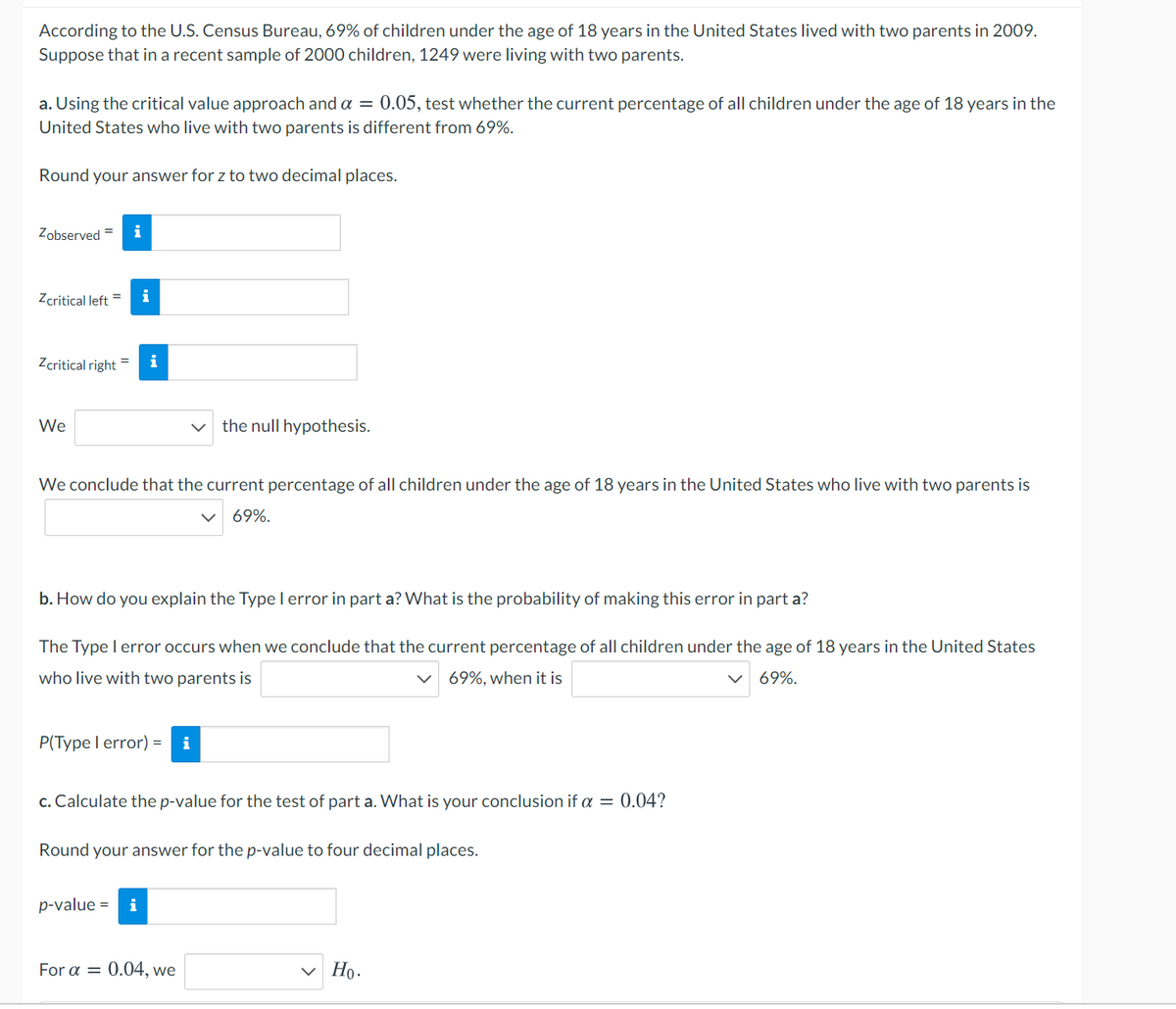According to the U.S. Census Bureau, 69% of children under the age of 18 years in the United States lived with two parents in 2009. Suppose that in a recent sample of 2000 children, 1249 were living with two parents. a. Using the critical value approach and a = 0.05, test whether the current percentage of all children under the age of 18 years in the United States who live with two parents is different from 69%. Round your answer for z to two decimal places. Zobserved = i Zcritical left = i Zcritical right i We the null hypothesis. We conclude that the current percentage of all children under the age of 18 years in the United States who live with two parents is 69%. b. How do you explain the TypeI error in part a? What is the probability of making this error in part a? The Type I error occurs when we conclude that the current percentage of all children under the age of 18 years in the United States who live with two parents is 69%, when it is 69%. P(Type I error) = c. Calculate the p-value for the test of part a. What is your conclusion if a = 0.04? Round your answer for the p-value to four decimal places. p-value = i For a = 0.04, we v Ho.
According to the U.S. Census Bureau, 69% of children under the age of 18 years in the United States lived with two parents in 2009. Suppose that in a recent sample of 2000 children, 1249 were living with two parents. a. Using the critical value approach and a = 0.05, test whether the current percentage of all children under the age of 18 years in the United States who live with two parents is different from 69%. Round your answer for z to two decimal places. Zobserved = i Zcritical left = i Zcritical right i We the null hypothesis. We conclude that the current percentage of all children under the age of 18 years in the United States who live with two parents is 69%. b. How do you explain the TypeI error in part a? What is the probability of making this error in part a? The Type I error occurs when we conclude that the current percentage of all children under the age of 18 years in the United States who live with two parents is 69%, when it is 69%. P(Type I error) = c. Calculate the p-value for the test of part a. What is your conclusion if a = 0.04? Round your answer for the p-value to four decimal places. p-value = i For a = 0.04, we v Ho.
Glencoe Algebra 1, Student Edition, 9780079039897, 0079039898, 2018
18th Edition
ISBN:9780079039897
Author:Carter
Publisher:Carter
Chapter10: Statistics
Section10.1: Measures Of Center
Problem 9PPS
Related questions
Question

Transcribed Image Text:According to the U.S. Census Bureau, 69% of children under the age of 18 years in the United States lived with two parents in 2009.
Suppose that in a recent sample of 2000 children, 1249 were living with two parents.
a. Using the critical value approach and a = 0.05, test whether the current percentage of all children under the age of 18 years in the
United States who live with two parents is different from 69%.
Round your answer for z to two decimal places.
Zobserved =
i
Zcritical left =
i
Zcritical right
i
We
the null hypothesis.
We conclude that the current percentage of all children under the age of 18 years in the United States who live with two parents is
69%.
b. How do you explain the TypeI error in part a? What is the probability of making this error in part a?
The Type I error occurs when we conclude that the current percentage of all children under the age of 18 years in the United States
who live with two parents is
69%, when it is
69%.
P(Type I error) =
c. Calculate the p-value for the test of part a. What is your conclusion if a = 0.04?
Round your answer for the p-value to four decimal places.
p-value =
i
For a = 0.04, we
v Ho.
Expert Solution
This question has been solved!
Explore an expertly crafted, step-by-step solution for a thorough understanding of key concepts.
Step by step
Solved in 2 steps with 2 images

Recommended textbooks for you

Glencoe Algebra 1, Student Edition, 9780079039897…
Algebra
ISBN:
9780079039897
Author:
Carter
Publisher:
McGraw Hill

Glencoe Algebra 1, Student Edition, 9780079039897…
Algebra
ISBN:
9780079039897
Author:
Carter
Publisher:
McGraw Hill